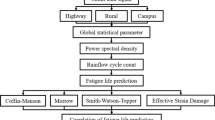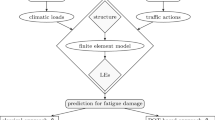Abstract
Fuel cell vehicles (FCVs) are an important direction for sustainable development of the automobile industry in the future. Still, the reliability and durability of FCVs are key technical problems affecting marketization. This study focused on fatigue reliability of FCVs under complex driving conditions. A dynamic analysis approach for fatigue reliability is proposed based on a dynamic Bayesian network and fracture mechanics (DBN-FM). According to the load spectrum data collected by an FCV on typical roads, a DBN model for the fatigue reliability of an FCV was established considering the randomness of variables in crack propagation. The practical application of the developed model is demonstrated through a case study. The results show that the DBN-FM approach can be used to predict the failure probability of FCVs under different driving distances. In addition, the weak parts of the FCV were identified, which provided theoretical guidance for its inspection and maintenance.















Similar content being viewed by others
References
Abimbola, M., Khan, F., Khakzad, N., & Butt, S. (2015). Safety and risk analysis of managed pressure drilling operation using Bayesian network. Safety Science, 76, 133–144.
Akama, M., & Ishizuka, H. (2008). Reliability analysis of Shinkansen vehicle axle using probabilistic fracture mechanics. Nihon Kikai Gakkai Ronbunshu, A Hen/transactions of the Japan Society of Mechanical Engineers Part A, 60(569), 46–51.
Amin, M. T., Khan, F., & Imtiaz, S. (2018). Dynamic availability assessment of safety critical systems using a dynamic Bayesian network. Reliability Engineering and System Safety, 178, 108–117.
Bergner, F., & Zouhar, G. (2000). A new approach to the correlation between the coefficient and the exponent in the power law equation of fatigue crack growth. International Journal of Fatigue, 22(3), 229–239.
Bougofa, M., Taleb-Berrouane, M., Bouafia, A., Baziz, A., Kharzi, R., & Bellaouar, A. (2021). Dynamic availability analysis using dynamic Bayesian and evidential networks. Process Safety and Environment Protection, 153, 486–499.
Cai, B., Liu, H., & Xie, M. (2016). A real-time fault diagnosis methodology of complex systems using object-oriented Bayesian networks. Mechanical Systems and Signal Processing, 80, 31–44.
Chang, Y., Wu, X., Chen, G., Ye, J., Chen, B., Xu, L., Zhou, J., Yin, Z., & Ren, K. (2018). Comprehensive risk assessment of deepwater drilling riser using fuzzy Petri net model. Process Safety and Environmental Protection, 117, 483–497.
Dai, H., Pei, F., & Hao, D. (2020). Safety Guidance for Fuel Cell Electric Vehicles (pp. 1–8). China Machine Press.
GB/T 39132–2020, Fuel Cell Electric Vehicle Engineering Approval Evaluation Program.
Gu, X., & Wu, Z. X. (2008). New empirical stress-intensity-factor equation for surface cracks. Engineering Mechanics, 25, 35–39.
Guo, H., & Yang, X. (2007). A simple reliability block diagram method for safety integrity verification. Reliability Engineering and System Safety, 92(9), 1267–1273.
Hughes, N., & Agnolucci, P. (2012). Hydrogen economics and policy—reference module in earth systems and environmental sciences/comprehensive renewable energy—4.03. Comprehensive Renewable Energy, 4, 65–95.
Hwang, J. J., Wang, D. Y., & Shih, N. C. (2005). Development of a lightweight fuel cell vehicle. Journal of Power Sources, 141(1), 108–115.
Iman, R. L., & Hora, S. C. (2010). A robust measure of uncertainty importance for use in fault tree system analysis. Risk Analysis, 10(3), 401–406.
ISO 23828:2013 - Fuel cell road vehicles —Energy consumption measurement—Vehicles fuelled with compressed hydrogen.
ISO 23273:2013 - Fuel cell road vehicles—Safety specifications—Protection against hydrogen hazards for vehicles fuelled with compressed hydrogen.
Khakzad, N., Khan, F., & Amyotte, P. (2011). Safety analysis in process facilities: Comparison of fault tree and Bayesian network approaches. Reliability Engineering and System Safety, 96(8), 925–932.
Khakzad, N., Khan, F., & Amyotte, P. (2013). Quantitative risk analysis of offshore drilling operations: A Bayesian approach. Safety Science, 57, 108–117.
Liu, X., Zheng, S., Feng, J., & Chen, T. (2015). Reliability reallocation for fuel cell vehicles based on genetic algorithm. Quality and Reliability Engineering International, 31(8), 1495–1502.
Madsen, H. O., Krenk, S., & Lind, N. C. (1986). Methods of Structural Safety. Canadian Journal of Civil Engineering, 13(3), 400.
Newman, J. C., Jr. (1998). The merging of fatigue and fracture mechanics concepts: A historical perspective. Progress in Aerospace Sciences, 34(5–6), 347–390.
Nie, Z., Chang, Y., & Liu, X. (2019). A DBN-GO approach for success probability prediction of drilling riser emergency disconnect in deepwater. Ocean Engineering, 180, 49–59.
Paris, P. C., & Erdogan, F. (1963). A critical analysis of crack propagation laws. Journal of Basic Engineering, 85(4), 528–533.
Susmel, L. (2010). Estimating fatigue lifetime of steel weldments locally damaged by variable amplitude multiaxial stress fields. International Journal of Fatigue, 32(7), 1057–1080.
Whittaker, J. A., Rekab, K., & Thomason, M. G. (2000). A Markov chain model for predicting the reliability of multi-build software. Information and Software Technology, 42(12), 889–894.
Wipke, K., Sprik, S., Kurtz, J., Garbak, J., (2008). Fuel Cell Vehicle and Infrastructure Learning Demonstration Status and Results. ECS Transactions, pp. 16.
Xu, G., & Zuo, B. (2007). Study on fatigue residual life evaluation method of crane structure. Chinese Journal of Safety and Science, 17(3), 5.
Yi, K. S., Lee, S. J., & Lee, K. I. (2001). Estimation of vehicle driving-load with application to vehicle intelligent cruise control. KSME Journal of Mechanical Science and Technology, 15(6), 720–726.
Yuanjiang, C., Jiayi, L., Changshuai, Z., Guoming, C., Xinhong, L., Shenyan, Z., Liangbin, X., & Leixiang, S. (2019). Dynamic risk assessment approach of riser recoil control failure during production test of marine natural gas hydrate. Energy Science & Engineering, 7(5), 1808–1822.
Zhao, F., Mu, Z., Hao, H., Liu, Z., He, X., Przesmitzki, S. V., & Amer, A. A. (2020). Hydrogen fuel cell vehicle development in China: An industry chain perspective. Energy Technology, 8, 2000179.
Acknowledgements
Thanks are given to domain experts for their input and insight without which this research would not have been possible. This project is supported by National Key Basic Research and Development Program (No: 2022YFE0103100). The authors deeply appreciate the anonymous reviewers' insightful comments and suggestions, which helped a lot in improving the present paper.
Author information
Authors and Affiliations
Corresponding author
Additional information
Publisher's Note
Springer Nature remains neutral with regard to jurisdictional claims in published maps and institutional affiliations.
Rights and permissions
Springer Nature or its licensor (e.g. a society or other partner) holds exclusive rights to this article under a publishing agreement with the author(s) or other rightsholder(s); author self-archiving of the accepted manuscript version of this article is solely governed by the terms of such publishing agreement and applicable law.
About this article
Cite this article
Nie, Z., Liang, R., Wu, Z. et al. Dynamic Fatigue Reliability Prediction Approach of Fuel Cell Vehicle Based on Usage Scenario. Int.J Automot. Technol. 25, 147–160 (2024). https://doi.org/10.1007/s12239-024-00024-8
Received:
Revised:
Accepted:
Published:
Issue Date:
DOI: https://doi.org/10.1007/s12239-024-00024-8




